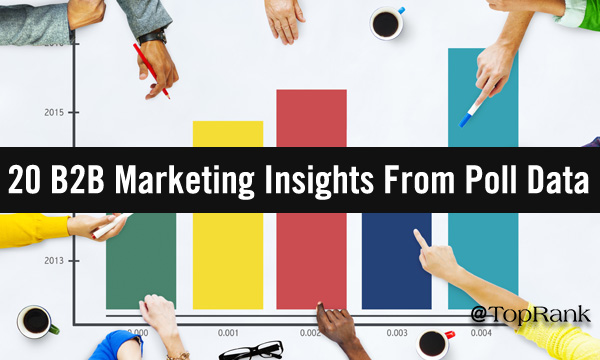
 What can poll results tell B2B marketers about a year unlike any other, and how can this valuable audience data help us refine our marketing strategy as we push towards 2021? For more than a year we’ve run weekly social media polls on our Twitter profile, and for several months now have simultaneously also placed a weekly user poll on our LinkedIn* page. We wanted to share some of the fascinating insights you have shared with us in the form of results from our polls, in order to see the trends that have emerged during this unprecedented year. Let’s look at trends in social media communications, how marketing is changing in 2020, and the rising effectiveness of B2B influencer marketing, all through the lens of poll-derived feedback.
What can poll results tell B2B marketers about a year unlike any other, and how can this valuable audience data help us refine our marketing strategy as we push towards 2021? For more than a year we’ve run weekly social media polls on our Twitter profile, and for several months now have simultaneously also placed a weekly user poll on our LinkedIn* page. We wanted to share some of the fascinating insights you have shared with us in the form of results from our polls, in order to see the trends that have emerged during this unprecedented year. Let’s look at trends in social media communications, how marketing is changing in 2020, and the rising effectiveness of B2B influencer marketing, all through the lens of poll-derived feedback.
Social Media Communication Expectations
Insight #1 — Social Response Times
How quickly do we expect a response from a brand when we ask a question publicly on social media? The majority marketers we polled expect to hear back from a brand within 24 hours, with 61 percent of respondents on LinkedIn expecting a reply within a day, 24 percent within one hour, and 16 percent by the end of the workday. Twitter respondents voiced similar sentiments, with 38 percent looking to get a reply from a brand within 24 hours, 33 percent by the end of the current workday, and 21 percent within an hour. If you’re not answering social media inquiries within 24 hours you may come under fire, as not even one respondent to our poll said that they expect brands to take longer than a day to reply.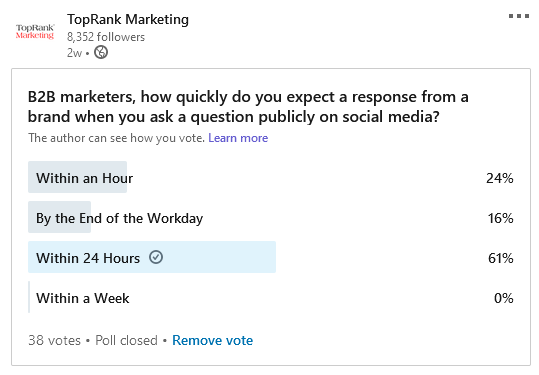
Insight #2 — Email Response Times
We also asked the same question for a different form of online communications, curious about expectations when sending an old-fashioned email to a brand. 50 percent of our Twitter poll respondents said that they expected an email reply within 24 hours, mostly echoing the expectations for public social media questions. 22 percent said they expected brands to reply by the end of the workday, 18 percent within a week — a notable difference from social media queries — and just 9 percent within an hour.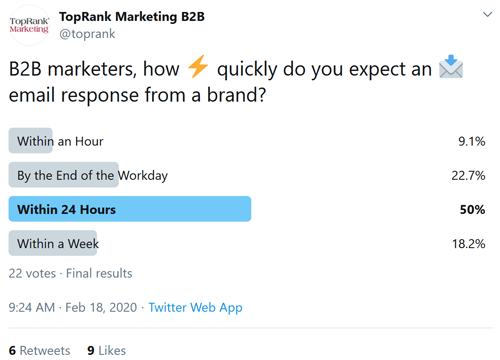
Insight #3 — Unfollowing
What drives people who have already taken the time and effort to follow a brand on social media to later unfollow them, and what messages can we learn from these mistakes? When we asked this question in a poll, our LinkedIn respondents said the top reason they unfollow brands comes down to posting poor quality content, followed by irrelevant content and brands that post too much content. Just two percent of respondents said that they unfollow brands that don’t post enough content. 44 percent of our Twitter respondents said that irrelevant content was their top reason for unfollowing a brand, followed by poor quality content at 33 percent, and too much content at 22 percent.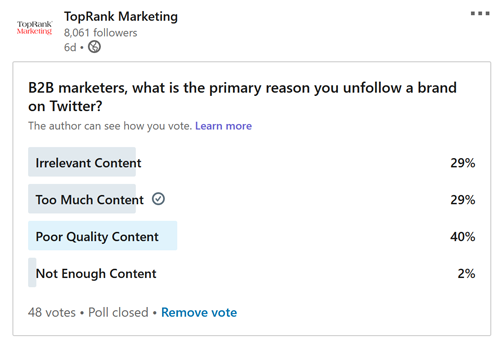
Insight #4 — Stories Format
We also ran a poll asking how the ephemeral stories format would fare on LinkedIn if the platform were to make its test of the post type a permanent part of the service. 33 percent of respondents said that LinkedIn Stories would be a great addition to the platform, while 25 percent felt it would be a good match. 25 percent also said that it would be an unlikely match, and 16 percent noted that the stories format would be a poor match for LinkedIn.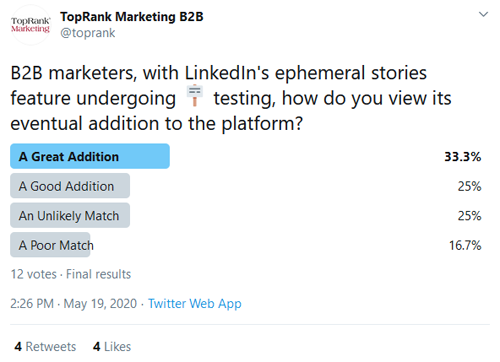
Insight #5 — Experiential Content
We were also curious how B2B marketers are using experiential content in 2020. 58 percent of our Twitter poll respondents said that they expected to incorporate experiential content very frequently into their marketing efforts during 2020, followed by 41 percent who planned to do so somewhat frequently.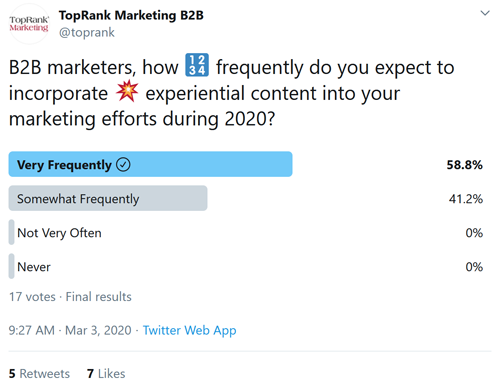 Experiential content is playing a greater role in B2B marketing efforts in 2020, which I looked at in “What B2B Marketers Need to Know About Experiential Content,” and our Nick Nelson examined recently in "How to Hit a Marketing Home Run with Experiential Content."
Experiential content is playing a greater role in B2B marketing efforts in 2020, which I looked at in “What B2B Marketers Need to Know About Experiential Content,” and our Nick Nelson examined recently in "How to Hit a Marketing Home Run with Experiential Content."
Insight #6 — Chatbots & Artificial Intelligence
How B2B marketers communicate is constantly shifting as new technologies become available and gain wider adoption. We asked our Twitter followers who use chatbots or other forms of messaging featuring artificial intelligence (AI) to chime in on how the technology has performed for them. 49 percent of B2B marketers who responded said that chatbots and AI-assisted technology has performed better than expected, yet 42 percent noted that the technology has under-performed, while 14 percent found that it performed as they had expected.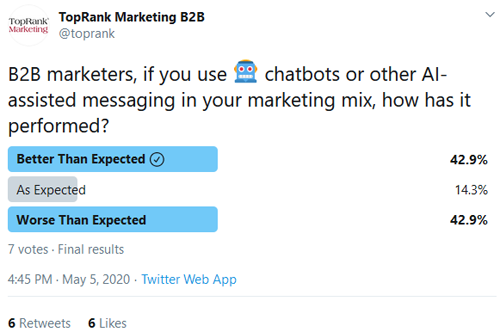
Insight #7 — Virtual Meeting Length
We were curious what our audience of B2B marketers on Twitter felt the most effective length of time might be when it comes to virtual meetings. 58 percent of respondents said that 30 minutes was the optimal length of time for effective virtual meetings, while 17 percent felt that 15 minutes or less works best, with 17 percent also noting that 45 minutes is the most effective, followed by just 5 percent who said an hour was best.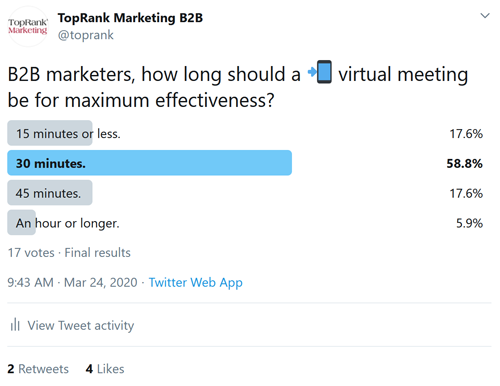
Insight #8 — Reviews & Testimonials
Another part of marketing communications is user feedback, reviews, and testimonials, and we asked our Twitter followers to share how often they use positive reviews in their marketing efforts. 47 percent of respondents said that they use positive reviews in their marketing efforts occasionally, however 23 percent noted that they never do, followed by 17 percent who said that they always do, and 11 percent who do so frequently.
Insight #9 — Newsletter Preferences
Speaking of email, we also wondered when B2B marketers prefer to receive monthly newsletters. 45 percent of our respondents said they prefer the first of the month, followed by 27 percent who are fond of mid-month newsletters, 18 percent who prefer a time early in the month, and 9 percent who want to see newsletters arrive at the end of the month.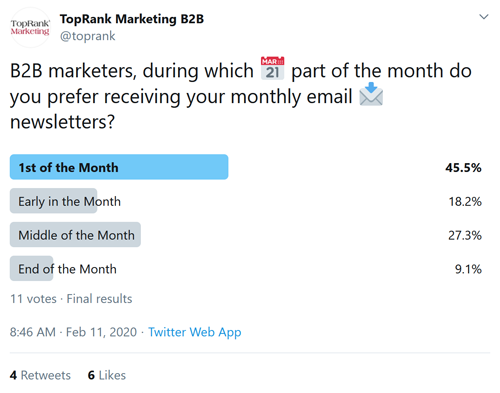
Insight #10 — The Emoji Divide
The use of emojis in social media messaging was an area of contention among our poll respondents. 35 percent said that emoji were somewhat effective, while the same number noted their use to rarely be effective. 17 percent said emoji were extremely effective, and some 11 percent noted that they never use them.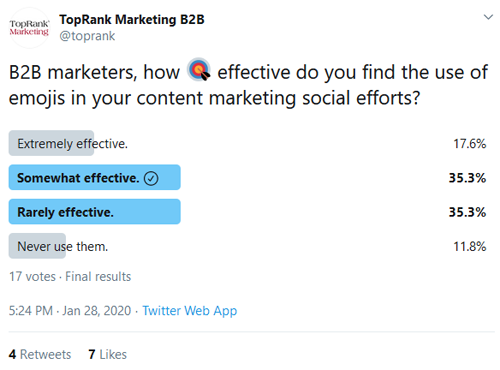
The Changing Face of 2020 Marketing
The global health crisis has changed the face of marketing events in 2020, as nearly all conferences have made the jump to virtual events, as I wrote about recently in "17+ Top Virtual Marketing Conferences for Summer 2020 & Beyond."Insight #11 — Virtual Event Attendance
Are B2B marketers planning to attend newly-virtual events, and if so how many? We asked our LinkedIn and Twitter users how many virtual marketing events they planned to attend over the final five months of 2020. Most respondents said that they will attend between one and five virtual marketing events, while the second most frequent choice was those who said they won’t be attending a single virtual event, followed by those who plan to attend between six and 10. Virtual events and webinars are undoubtedly seeing an unexpected golden age this year, and we’ve explored how to best utilize them, in “How B2B Marketers Can Get the Most Out of Webinars in 2020.” [bctt tweet="“One great way to promote the webinar, and focus your content at the same time, is to poll your audience via social media. Ask for their thoughts on your topic. Ask what they most want to know about it.” @NiteWrites" username="toprank"]
Virtual events and webinars are undoubtedly seeing an unexpected golden age this year, and we’ve explored how to best utilize them, in “How B2B Marketers Can Get the Most Out of Webinars in 2020.” [bctt tweet="“One great way to promote the webinar, and focus your content at the same time, is to poll your audience via social media. Ask for their thoughts on your topic. Ask what they most want to know about it.” @NiteWrites" username="toprank"]
Insight #12 — Top Pain Points
We wanted to find out what the biggest pandemic pain points have been for B2B marketers, and among those answering our LinkedIn poll 64 percent said that a decrease in budget or business has been the top challenge, followed by the difficulty in engaging customers at 36 percent. 46 percent of Twitter respondents also revealed that falling budgets and business were their top pain points, followed by engaging customers at 38 percent and remote work issues for some 15 percent of marketers.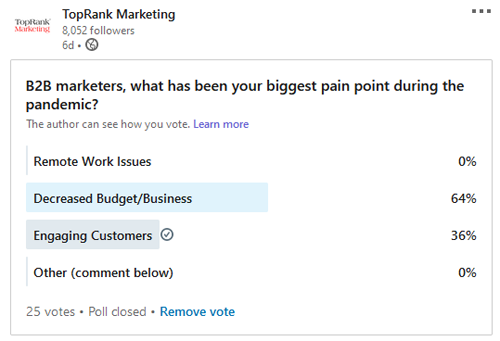
Insight #13 — Learning New Skills
63 percent of poll respondents said that they have used their time during the pandemic to learn new marketing skills online, while 18 percent said that they planned to do so.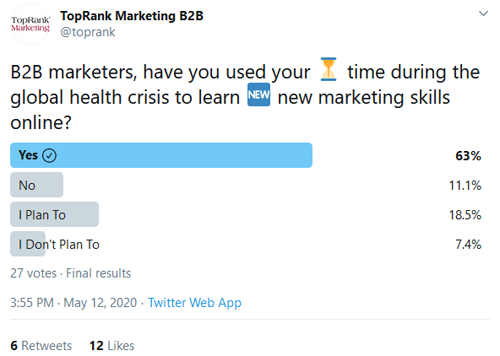
Insight #14 — Digital Asset Management
54 percent of B2B marketers we polled on Twitter said that they either already use a digital asset management (DAM) solution in their marketing stack or plan to implement one, while 45 percent didn’t use a DAM.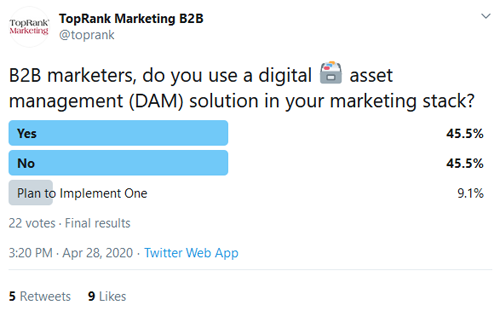 If you aren't familiar with how DAM can help B2B marketers, I looked into the issue in "Why B2B Marketers Should Give a DAM: Top Tips on Digital Asset Management."
If you aren't familiar with how DAM can help B2B marketers, I looked into the issue in "Why B2B Marketers Should Give a DAM: Top Tips on Digital Asset Management."
Insight #15 — Podcast Growth
With U.S. podcast listeners topping the 100 million mark for the first time in 2020, we wondered how the global health crisis has affected listening frequency among B2B marketers. 40 percent of our Twitter respondents said that they have been listening to more podcasts during the pandemic, with 22 percent noting that they’ve listened to fewer, 18 percent about the same amount, and another 18 percent who said they don’t listen to podcasts.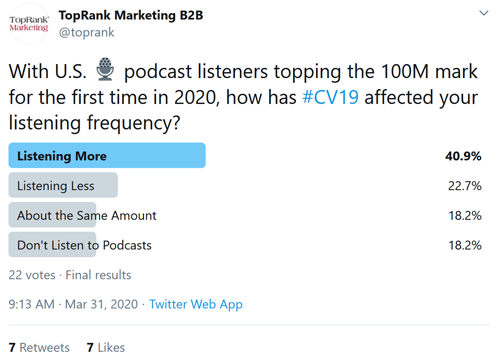
Insight #16 — Streaming Ad Use
With numerous studies showing that streaming music ads were booming in 2019, we wondered what B2B marketers planned for 2020, and 50 percent of our Twitter poll respondents said that they had no streaming ad plans for the year, while 25 percent said they planned to implement more streaming ads, 16 percent fewer of them, and 8 percent about the same.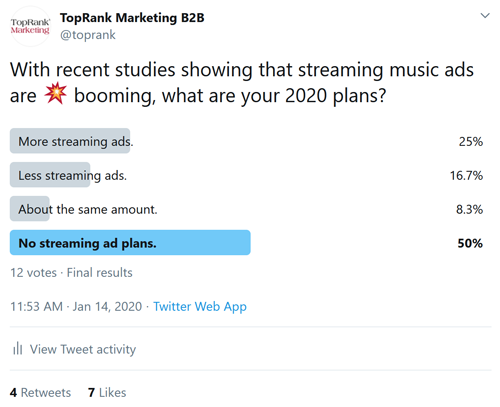
Insight #17 — The Customer Journey
Content creation efforts are also shifting in 2020, and we asked B2B marketers to share which stage of the customer journey they are focusing on the most. 47 percent of respondents said that generating awareness was where they were placing the greatest focus, followed by brand advocacy at 35 percent, consideration and intent at 11 percent, and evaluation and purchase at 5 percent.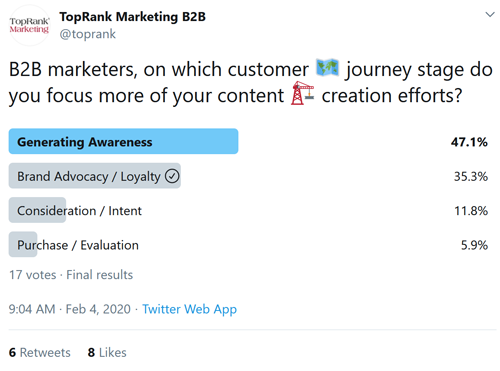
The Rising Effectiveness of Influencer Marketing
Insight #18 — Influencer Marketing Program Length
We asked our LinkedIn and Twitter followers to chime in on the ideal length of time a B2B influencer marketing program should run for maximum effectiveness, and the majority of our savvy followers chose always-on and ongoing programs — 73 percent of our LinkedIn respondents and 64 percent of our Twitter respondents. Influencer marketing programs encompassing at least two campaigns was the second most popular choice, the choice of 21 percent of LinkedIn respondents and 18 percent of our Twitter respondents.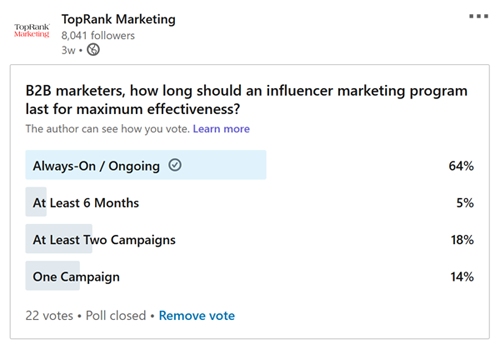
Insight #19 — Pandemic Focus Areas
We asked B2B marketers which area of marketing they were the most likely to increase focus on during the global health crisis, and topping the list was influencer marketing at 35 percent, followed by content marketing at 30 percent, search marketing at 20 percent, and email marketing, which garnered 12 percent of the poll responses.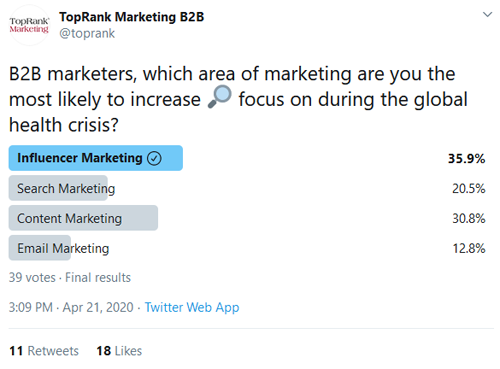
Insight #20 — Volume of Influencer Marketing Work
We were also curious how the pandemic has affected the volume of work B2B marketers have done with influencers. The greatest number of our respondents — some 36 percent — said that their volume of work with influencers had increased, followed by 32 percent who said that they didn’t use influencers, 24 percent who found that the volume of work was about the same, while 8 percent noted that the volume decreased.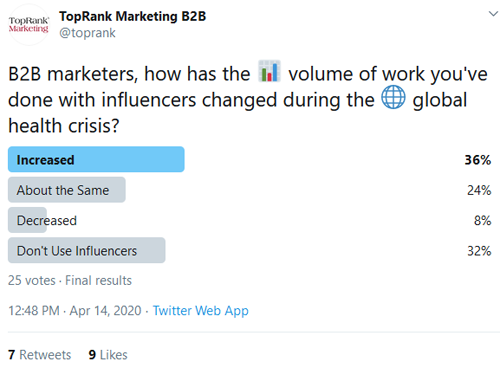
Listening To Your Audience & Taking Action
via GIPHY Keeping your finger on the pulse of your audience — whether it’s from poll results, surveys, questionnaires or other forms of feedback — goes a long way when it comes to making your marketing efforts authentic, and will help ensure that your communication is a two-way street and not just a publish-and-forget effort. We hope you’ve found this glimpse into some of our own poll results helpful as you navigate the sometimes murky marketing waters 2020 has given us. Let us know your thoughts by voting in our current weekly poll about Instagram's new short-form video offering, Reels — you'll find it on LinkedIn here and on Twitter here. You can learn more about poll data and statistics, and how to get more from audience feedback in every form by taking a look are some of the related articles we’ve written on the subject, such as the five listed here:- Social Media Polls For Marketers: 6 B2B Brands Winning With LinkedIn Polls
- 17 Revealing B2B Marketing Insights From Poll Data
- The Power of Social Media Polls: The Drill-Down on 3 Platforms + 5 General Best Practices
- 24 Essential B2B Influencer Marketing Statistics
- Hungry for More: What B2B Marketers Need to Know About Episodic Content
The post Show Me The Numbers: 20 B2B Marketing Insights From Audience Poll Data appeared first on Online Marketing Blog - TopRank®.
from Online Marketing Blog – TopRank® https://ift.tt/31IVN9U
via IFTTT
No comments:
Post a Comment